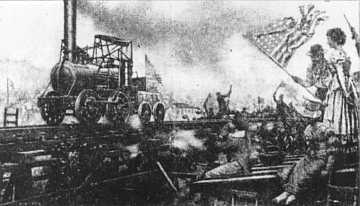
Pennsylvania's Historic
Stourbridge Line
A Tom Walz Adventure
I’ve always been a fan of the Guinness book of World Records. The biggest, fastest, smallest, etc. I also find “firsts” equally alluring. The Stourbridge Line was the first commercial railroad in the U.S. to have a steam-powered locomotive operate on it. Ok, I hear you, how can it be a railroad without an engine?
Up in Northeast Pennsylvania, land of hard anthracite coal, there was a railroad that went from Carbondale to Honesdale . Stationary steam engines hauled empty cars capable of holding about six tons of coal up a series of inclines, sixteen miles up the side of a mountain to the mine in Carbondale. The cars were then loaded with coal and coasted back down to the canal. This was known as a “gravity railroad.” The rails were made of oak, covered with iron straps, held in place by screws. For more info on this railroad: www.waynehistorypa.org/gravityrr.asp
Since this particular website is dedicated to railbiking I guess I’d better keep to the subject at hand.
I did a little research for a certain unnamed speeder club guy who seemed to have a bad taste in his mouth about railbikers, calling us “bootleggers.” I felt that if I helped him out it would cool his jets. He maintained his heat but in the process I stumbled across a website of speeder club from Northern New Jersey with a full web article on a meet they had planned on, and pulled off on “The Stourbridge Line.” The description of this line whet my appetite for another railbike adventure.
I have some friends who live up that neck of the woods so I arranged a visit with an obvious side trip. I checked the rails out and indeed, they looked ripe for a railbike ride. I checked a Mapquest map of Hawley, PA and followed the railroad all the way to the Delaware River, a nice 13-mile jaunt all through the woods along a river. Plans were made.
I found out through another friend up that way that the rail line had been shut down. A flood in the spring of 2005 washed out a bridge on the railroad. He did his best to describe where to put on to get around the washed out bridge. It ended up that I couldn’t find the street he mentioned so I just found a good place to park my car, took the railbike to the rails and set up. A guy in a pickup stopped by and said “cool rig” and then told me there was a washout about ¼ mile down the tracks. I told him I’d just check it out just the same and proceed per his directions to a place where I could put on past the washout.
I rode that ¼ mile and found that only one section of the bridge was gone and the rails were still hanging there. Now I had my chance to do the daring feat as on the cover of “Railbike, Cycling on Abandoned Railroads.” I snapped some pictures of this bridge then got on the bike and sloooowly crossed the washout. Phew! That was cool… scary… but cool.
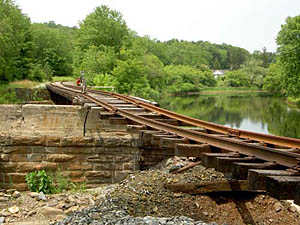
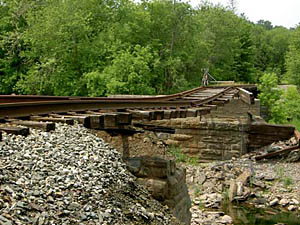
Off I went into the woods. Damn, this was nearly as pretty as my ride in the Adirondacks. Being that this line goes through the woods and that it hasn’t been used in well over a year, there were pesky little sticks on the tracks wherever the woods closed in on the right-of-way. I managed to plow most of the sticks off the rails with my guide but occasionally, I had to dismount and remove the bigger ones. Here
and there I came across a tree fallen across the rails and in one cut there was a pile of stone on the rail from a mini-avalanche. It was just a matter of picking up the bike and carrying it over or around the obstacles.
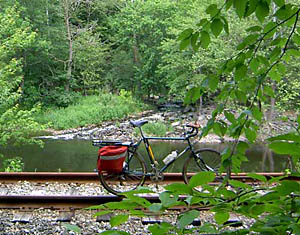
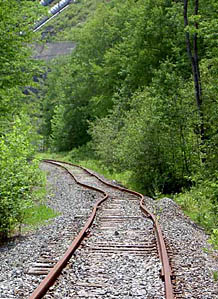
One thing I couldn’t help but notice was the excellent condition of the rail. Every joint was perfect and tight and the gauge was always consistent. My rig does adapt well to variations but still, it works best when conditions were like this.
The rails kept on all along the beautiful Lackawaxen River. Occasionally, the rails drifted away from the river but they always returned. The weather was hot, well into the 90’s with that classically oppressive Eastern humidity. I slugged down one of two of my huge water bottles by the end of the line.
The end of the line was quite distinct. After a road crossing there was some rolling stock, track maintenance equipment and the sure thing that determines that its time for railbikers to exit, a well used section of welded rail.
Above: How these rails got moved is beyond me. It certainly proved to be no problem for a railbike.
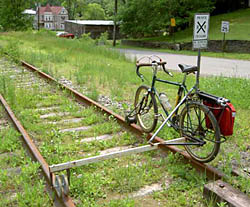
My starting point - with official "No Trespassing" sign. It was obvious from the condition of the line that no one had used it for many years.
Contemporary painting depicting the historic first run of the Stourbridge Lion at Honesdale, Pennsylvania, August 8th 1829
Left: The rails followed the beautiful Lackawaxen River all the way to the Delaware River.
I was now in the little hamlet of Lackawaxen proper. Being one of those “don’t blink as you’re passing through” kind of towns didn’t make it any less historical. I folded up the rig, put the bike on the road to checked it out.
I came across something I’d not expected, the Zane Grey museum. Zane Grey was a well knows writer of Western (cowboy) novels. Here’s a guy who wrote about all things Western and where did he live? He lived (and is buried) in Lackawaxen, Pennsylvania. Whodathunkit?
A quarter mile from the museum was another landmark; an aquaduct built by the famous John Roebling, whose crowing glory was the designing and building of the Brooklyn Bridge in 1887. At one time the Delaware and Hudson Canal went from the coal regions of Pennsylvania to the Hudson River right over the Delaware River. That’s right, a canal went over a river on a bridge. The bridge is now a one-lane bridge for cars and has been completely and beautifully restored.
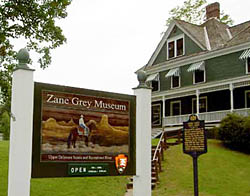
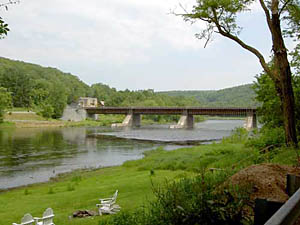
It was now time to head back. I pedaled back to the rails only to find that a weld had broken on my outrigger. It was now useless. I couldn’t ride the rails back. I was bummed. I had heard occasional traffic on the other side of the Lackawaxen River so I decided to find the road. Sure enough the road not only followed the river but there was still pieces of the D&H Canal still intact along it so I could continue my historic quest while heading for my starting point.
The miles slid by as I pedaled my ungainly bike through the woods on marginal pavement. My vision of it being a breeze to pedal all the way back was suddenly dashed by what looked like a wall in front of me. It was a hill, a big hill. But... being the optimist that I am I figured that I’d grind up over this incline and be back along the river in no time… NOT!!!
One hill led to another, then another and another. I even was forced to do the ultimate cycling enthusiast’s no-no of getting off and pushing the bike up the hill because it was so steep. Riding this bike on these hills proved quite challenging, not only because the bike, being ungainly at those slow climbing speeds, but as far as bicycles go, this thing is heavy. I sucked down my second water bottle in no time. My water was all gone and the hills just kept coming. Then I saw a landmark on the other side of the river. I knew I was no more than five miles from my car and more water. Like “The little train who could,” I kept pedaling… “I think I can, I think I can…”
Finally, the road turned downhill but not without a couple more uphills in between to make me feel at home. Finally, I got to my car, my water and a bite to eat. Aaaaaaaaah!
Gotta try this ride again. Next time I’m bringing a chainsaw. Oh yeah, my welding is a lot better now too. I didn’t like that arrangement anyway.
For those interested in the history of this line check the links below.
Link to an British site where “The Lion” was made.